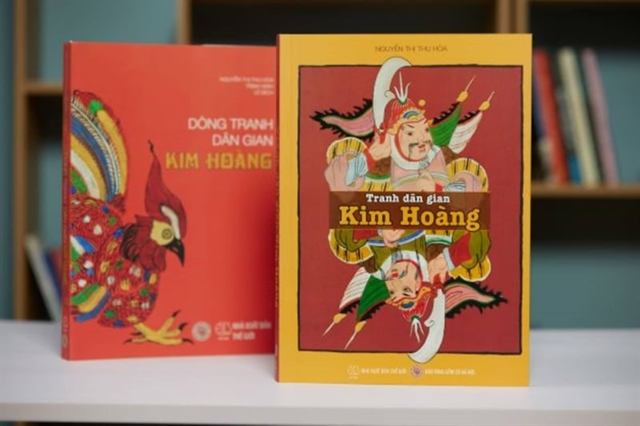.jpg) Life & Style
Life & Style


|
| Collector and director of Hà Nội Ceramic Museum Nguyễn Thị Thu Hòa. — VNS Photo Nguyễn Bình |
Collector and Director of Hà Nội Ceramic Museum, Nguyễn Thị Thu Hòa, has launched a new version of her book on Kim Hoàng folk painting. The first edition was published in 2019 focusing on history, technique and atheistics of Kim Hoàng folk paintings. The new book has been updated about the development of the painting in modern life.
Việt Nam News reporter Nguyễn Bình spoke to Hòa about the book and Kim Hoàng painting restoration.
What can you tell us about Kim Hoàng folk painting?
People often think of Đông Hồ painting and Hàng Trống painting when they refer to Tết paintings. Kim Hoàng is one of the popular paintings from ancient citadel.
It was formed in the second half of the 18th century, originating from Kim Hoàng Village, Vân Canh Commune, Hoài Đức District, Hà Nội.
It has themes that are familiar to rural people's lives and have diversified genres such as Tết painting, worship painting and decoration painting. It is usually used to hang on the wall to chase away evil spirits and keep the house safe.
When did you begin to creat the book?
Kim Hoàng paintings seem to be in danger of being lost if there is no timely restoration and promotion of the value of the paintings.
We have carried out the project Restoring Kim Hoàng Folk Paintings since 2015. This book came from the project to affirm its position in Vietnamese folk paintings.
The project has been made with participation of artisans, researchers, collectors, painters and photographers.
The story of Kim Hoàng folk paintings is not only about its history and its printing technique but also about the restoration.
Six years is not long time for the restoration. This book is a comprehensive look about the origin of Kim Hoàng paintings, the traditional way of producing the paintings and the challenges in preserving and developing this traditional form in modern life.

|
| The new version of Tranh Dân Gian Kim Hoàng (Kim Hoàng Folk Painting). — VNS Photo Nguyễn Bình |
What are the difficulties in the restoration process?
We went to the Kim Hoàng Village and met artisans. They told us how to make the paintings and they helped us to examine basic colours.
During the time, we got access to a rare book entitled Tranh Dân Gian Việt Nam (Việt Nam Folk Paintings) published in 1960 by French researcher Maurice Durand. The book includes Đông Hồ, Hàng Trống and Kim Hoàng paintings.
Thanks to the book, we found the clue to restoring Kim Hoàng paintings. We selected Kim Hoàng paintings from the book and worked with the artisans and other painters to discuss each painting to find it's uniqueness.
When I encountered difficulties, I really wanted to give it up. The biggest difficulty was turning a Kim Hoàng villager who does not have fine arts background into a folk painting artisan. Five villagers tried but only one was successful.
What are the distinctions between Kim Hoàng and other folk paintings?
Kim Hoàng paintings are printed on sheets of paper that are dyed beforehand with red colour.
That’s the highlight feature of this traditional painting school. Through this book, the author helps readers distinguish the paintings of Hàng Trống, Kim Hoàng and Đông Hồ paintings.
What do you hope to achieve from the project and the new book?
The efforts of Đông Hồ, Hàng Trống, and Kim Hoàng artisans have had an amazing result. After 75 years of absence, Kim Hoàng paintings have returned.
I hope this book and project will inspire people to continuously research and develop Kim Hoàng paintings. The most important thing is to arouse the villagers' the pride and sense of protection of the paintings.
The project is successful because it helps train now a young Kim Hoàng painting artisan and he earns a living with the job.
Hopefully, our project will contribute to Kim Hoàng paintings preservation and development.
We want to build a small museum in Kim Hoàng Village to preserve and develop Kim Hoàng paintings. We want this type of folk painting to develop independently like others. — VNS




